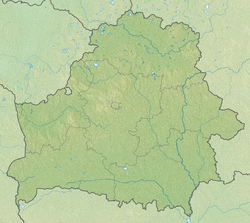Grodno
Гродна • Гродно Hrodna | |
|---|---|
| |
| Coordinates: 53°40′N 23°50′E / 53.667°N 23.833°E | |
| Country | Belarus |
| Region | Grodno Region |
| Founded | 1127 |
| Government | |
| • Chairman | Andrej Chmiel |
| Area | |
| • Total | 142.11 km2 (54.87 sq mi) |
| Elevation | 137 m (449 ft) |
| Population (2024)[1] | |
| • Total | 361,115 |
| • Density | 2,500/km2 (6,600/sq mi) |
| Time zone | UTC+3 (MSK) |
| Postal code | 230000 |
| Area code | +375-15 |
| License plate | 4 |
| Website | Official website |
Grodno (Russian: Гродно [ˈɡrodnə]; Polish: Grodno [ˈɡrɔdnɔ] ) or Hrodna (Belarusian: Гродна, IPA: [ˈɣrɔdna])[2] is a city in western Belarus. It is one of the oldest cities of Belarus.[3] The city is located on the Neman River, 300 kilometres (190 mi) from Minsk, about 15 kilometres (9.3 mi) from the border with Poland, and 30 kilometres (19 mi) from the border with Lithuania. Grodno serves as the administrative center of Grodno Region and Grodno District, though it is administratively separated from the district.[1] As of 2024, the city has a population of 361,115 inhabitants.[1]
The modern city of Grodno, founded in 1127, originated as a small fortress and trading outpost on the border of the Baltic tribal union of the Yotvingians.[3] It was also a home to the Dregoviches Slavic tribe.[3] It was a significant city in Black Ruthenia and later part of the Grand Duchy of Lithuania, which joined the Polish-Lithuanian Union in 1385. Grodno faced numerous invasions, most notably by the Teutonic Knights. The city was a key trade, commerce, and cultural center in the Polish-Lithuanian Commonwealth, and one of its royal residences, and de facto capital in the 1580s. The grand dukes allowed the creation of a Jewish commune in 1389, and the city received its charter in 1441. Grodno was the site of two battles during the Great Northern War.
Grodno has a rich history with various rulers and influences. In 1793, Grodno became the capital of the Grodno Voivodeship, but was annexed by Russia in 1795 after Third Partition of Poland. The city had a significant Jewish population before the Holocaust. After WWI, it was briefly part of the Belarusian People's Republic and the Republic of Lithuania before being taken over by Poland. During WWII, it was occupied by the Soviet Union and later by Nazi Germany. Since 1945, Grodno has been part of Belarus. Today, it has a diverse population, including Belarusians, Poles, and a small Jewish community. The city is known for its historical architecture, including the Old Grodno Castle, and is a center for Roman Catholicism and Polish culture in Belarus.
- ^ a b c "Численность населения на 1 января 2024 г. и среднегодовая численность населения за 2023 год по Республике Беларусь в разрезе областей, районов, городов, поселков городского типа". belsat.gov.by. Archived from the original on 2 April 2024. Retrieved 12 April 2024.
- ^ official transliteration
- ^ a b c "Iz istorii goroda grodno". zetgrodno.com.








